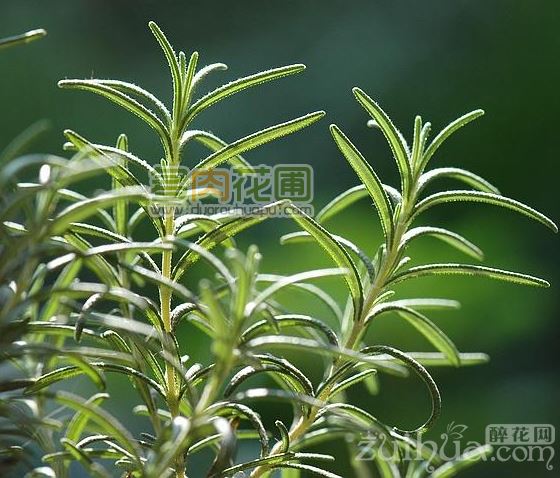How to raise rosemary?
How to raise rosemary? Rosemary is an evergreen shrub native to Europe. With rich and clear aroma, it can be used as western food spice. Naturally growing shrubs can be more than 2 meters high. If balcony pots are used, the plant height can be controlled in the range of 30 to 40 centimeters because the roots are controlled. The root system is well developed, and the soil layer of the main root is 20cm to 30cm. The plant is 30-40 cm high, the stem is 0.5-0.8 cm in diameter, and the shoots are opposite at the base of the stem, 10-12 cm long. The leaves are opposite, with dense nodes and tender foliage. The leaves are 2.5 cm long and 0.2 cm wide. Let's learn how to raise rosemary.
Rosemary can be planted and cultivated in the family, and twigs can be used for softwood cuttings during the Meiyu period. If it is planted for the first time, it can be propagated by sowing.
The amount of seedlings needed for family courtyard cultivation is small, so small seedling trays can be used to cultivate seedlings. Soak rice chaff about 4cm thick, compacted, then put 1cm thick culture soil, spread seeds, cover 0.5cm culture soil, spray wet culture soil with sprayer, cover with thin film, keep indoor heat preservation for about 25 ℃, about 12 days and 15 days.
After emergence, uncover the film in time and put it on the windowsill to keep the light, moist bed soil and suitable temperature conditions, so that the seedlings can grow normally. When the seedlings are 2 cm to 3 cm high, the seedlings are divided and planted in a small plastic bowl with a diameter of 9 cm. At the end of that year, the seedlings have grown up and need to turn the basin and change to a slightly larger plastic basin with a diameter of 18 cm, so that the roots can develop in the new culture soil.

As for rosemary fertilization, don't worry about it. Vanilla plants don't need fertilizer. However, make sure the soil contains some lime.
How do you keep rosemary? 1. Light and temperature.
Rosemary likes a warm and suitable environment and can be planted all the year round in the south, while it is mostly used in pot farming in the north, which is conducive to moving indoors to keep warm in winter. Rosemary likes the sun and should be exposed to no less than 8 hours of sunlight every day. High temperatures in summer can be properly shaded.
2. Soil.
Rosemary is suitable for growing in alkaline soil, and some quicklime can be added to acidic soil to make the soil suitable for rosemary growth, and the stronger the alkaline soil is, the stronger the aroma of rosemary is.
3. Watering.
Rosemary is more resistant to drought, pay attention to dry watering, usually once every two days, thoroughly each time. Watering should be reduced in winter to enhance cold resistance and anti-freezing.
4. Fertilization.
Rosemary does not have high requirements for fertilizer, is more resistant to thin ridges, and general vanilla plants do not need fertilizer. During the growth period, appropriate amounts of nitrogen and phosphate fertilizer can be applied to promote growth.
5. Trim.
In order to maintain the shape of the potted plant, rosemary can be pruned three months after it has been planted. Generally, the branches that are too dense and too long are trimmed, and the withered branches are pruned in time, which can ensure ventilation and ventilation and make the plants grow healthily.
Above is the introduction of rosemary culture methods. The following editor will talk about the prevention and control of diseases and insect pests of rosemary in family care.
- Prev

Plum blossom bonsai modeling and pruning: old pile plum blossom bonsai branch pruning, freshly trimmed red plum bonsai picture
Plum blossom bonsai pruning. After several years of shaping and blooming, plum blossom bonsai is pruned reasonably every year in early spring after 80% of the flowers lose their ornamental effect and before sprouting, so as to promote the flowering of new branches and maintain and develop the original situation of plum bonsai. The better its charm
- Next

How to grow rosemary
How to grow rosemary how to grow rosemary in the courtyard, rosemary can be used for tender wood cutting during the Meiyu period. If it is planted for the first time, it can be propagated by sowing. Sowing and raising seedlings: the amount of seedlings needed for family courtyard cultivation is small, so small seedling trays can be used to cultivate seedlings. Deep turning, border making and fertilization: before planting
Related
- Fuxing push coffee new agricultural production and marketing class: lack of small-scale processing plants
- Jujube rice field leisure farm deep ploughing Yilan for five years to create a space for organic food and play
- Nongyu Farm-A trial of organic papaya for brave women with advanced technology
- Four points for attention in the prevention and control of diseases and insect pests of edible fungi
- How to add nutrient solution to Edible Fungi
- Is there any good way to control edible fungus mites?
- Open Inoculation Technology of Edible Fungi
- Is there any clever way to use fertilizer for edible fungus in winter?
- What agents are used to kill the pathogens of edible fungi in the mushroom shed?
- Rapid drying of Edible Fungi

